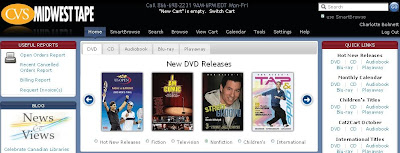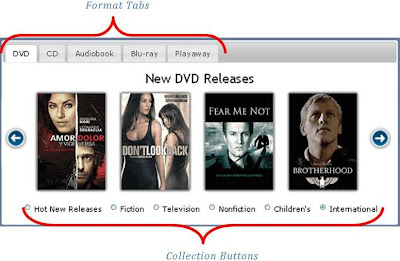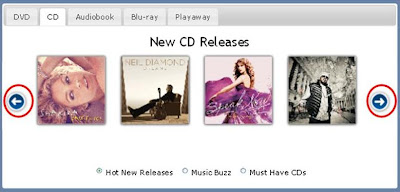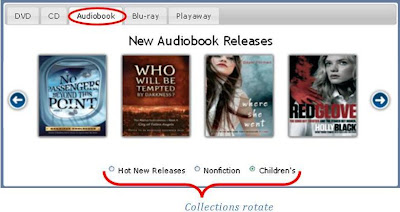Netflix, the world’s largest online video streaming subscription service, made its Canadian debut on September 22. Due to content and bandwidth limitations, this service stands to be supplemental rather than threatening to DVD and Blu-ray library collections.
Availability of Content
While libraries are able to circulate DVDs and Blu-rays on their actual street dates, new releases from several major studios debut on Netflix two to three months after they physically appear on video store shelves. Additionally, Netflix’s Canadian database offers a limited selection— just over 7,000 English-spoken titles. The majority of these titles are television shows, documentaries, older movies, and limited release art films.
The lack of content so far can be attributed to strict and complex licencing requirements. Netflix doesn’t own the movies they stream; rather, they licence them from studios, authors, musicians, writers, and directors. And even though Netflix may have acquired more substantial content rights in the United States, these rights do not transfer to Canada. Online media distributors, including Netflix, must acquire Canadian licencing from broadcast rights holders. 1
Even though Netflix provides streaming video on-demand, it may be a challenge for patrons to find videos they want to see. Therefore, libraries can expect their patrons to continue to rely on their local branch’s DVD and Blu-ray circulations for new releases and titles that have yet to be licensed by Netflix.
Bandwidth Limitations
In addition to content issues, Canadian Netflix subscribers also face bandwidth limitations. Internet providers in Canada enforce bandwidth caps that restrict the amount of data a user can transfer throughout the month. For example, high-speed internet provider Rogers offers plans that range from 2 gigabytes a month to 175 gigabytes. 2 However, an average HD movie consumes 2 gigabytes of bandwidth per hour while one hour of normal video uses 1 gigabyte per hour. 3 Therefore, a Netflix subscriber could easily surpass his or her monthly allotment of bandwidth by watching just a couple of movies a week, depending on their plan.
Bandwidth overages can result in charges anywhere from $.50 to $5.00 for each additional gigabyte used. 2 Consequently, for some users Netflix may end up costing significantly more than the initial $7.99 a month. Because of this, many library patrons will continue to use the free services provided by libraries rather than streaming services, especially in today’s uncertain economy.
In conclusion, while Netflix offers an additional entertainment option for Canadian audiences, there are significant drawbacks to the new service, specifically limited content and restricted bandwidth—which can greatly affect total cost for the consumer. Thus, libraries and the quality DVD collections they provide will continue to serve as a valuable resource for their communities.
What do you think of Netflix’s presence in Canada? Have your patrons provided any feedback? Do you foresee Netflix having any affect on circulation or patron base? Share your thoughts here as comments.
1 http://www.thestar.com/news/sciencetech/technology/lawbytes/article/871980--geist-why-are-u-s-net-services-slow-to-migrate-north?bn=1
2 http://www.hispeed.rogers.com/bband/content/keepingpace/faq.html
3http://www.ottawacitizen.com/business/services+slow+make+their+north/3623416/story.html#ixzz11lxNbZS9
At CVS Midwest Tape, we take pride in our ability to help libraries solve problems. As a customer-focused company, we do our best to work with libraries to develop solutions that work for their specific situations. In an effort to share workable solutions as well as better illustrate our resources, we will be sharing some of our success stories here on News & Views.
In this entry, IT tester and coordinator Walt Waltzer shares his experiences with 9xx ordering:
One of the more important aspects of the library business is collection development. When collection development becomes time consuming and complicated, the library and its patrons suffer the burden. One way we try to help lighten library workloads is setting up 9xx ordering.
9xx ordering is a method in which a customer uses capabilities of their ILS to electronically assist with the ordering process. 9xx refers to a MARC record tag (in the 900s) that is populated with unique customer information to allow the electronic submission or import of orders. Adding 9xx can greatly improve workflows by reducing the time spent developing collections and simplifying the steps to do so.
9xx in Action One of our customers was overwhelmed by the complexity of their collection development workflow. The below slide shows their initial workflow and includes at least 15 distinct steps to the process including printing copies and handwriting orders, two very time and resource consuming steps.
Through collaboration with CVS Midwest Tape, this library decided to use 9xx to improve the accuracy of their orders and greatly reduce the amount of time needed to develop collections. By doing so, this customer was able to streamline the process down to 6 steps, as shown below. This also brought better order tracking and monitoring which allows for better communication with patron material requests.
Interested in setting up 9xx ordering with CVS Midwest Tape? Contact Customer Service at 866.698.2231 to be connected with a 9xx specialist.
This has been the first instalment in our Success Stories series. Do you have a success story you’d like to share? Email newsandviews@midwesttapes.com to share your experience. You can also post your experiences with 9xx or your feedback on this series here as comments.
A few months ago, CVS Midwest Tape posted a blog discussing 3D: the Future of Entertainment. Since then 3D movies have bombarded the big screen, some even becoming summer blockbusters. But despite big screen popularity, Hollywood industry leaders and consumers alike seem to be forming a resistance toward the emerging 3D entertainment trend.
Hit or Miss
So far, six of this year’s top ten films hit theaters in 3D and altogether more than 20 3D films will release by the end of the year. But while some 3D films like Avatar($749M), Toy Story 3 ($404M), Shrek Forever After ($238M), and Alice in Wonderland ($334M) dominated the box office this summer, others fell short. Films converted to 3D at the last minute like Clash of the Titans ($163M), Step Up 3D ($42M), and Piranha 3D ($18M) drew less than favorable crowds that ended up leaving theaters disappointed.
According to the president of Hollywood.com Box Office, Paul Dergarabedian, “As revenues from 3D films rise, there is a great temptation to see the technology as the salvation of the industry.” 1 In the next two years, producers will release nearly 60 3D films. But industry experts argue that just because it is possible to make a film in 3D, doesn’t mean it should be done every time. According to film critic Roger Ebert, “The 3D in Clash of the Titans was hastily added in postproduction to ride on the coattails of Avatar.” 2 DreamWorks Animation CEO Jeffrey Katzenberg agreed, associating the term “cheeseball” with the film. 2
Rereleasing classics in 3D
Due to the growing popularity of 3D films, popular classics like Titanic and Beauty and the Beast are being remastered into the 3D format. To do this, two offset images need to be created from one flat picture. Graphic artists may separate a shot of a man standing in front of a wall into three layers: the man, the wall, and the sky. They then turn the image into a topographical map by drawing depth lines around all of the objects on each of the individual layers. Next, computer software creates new, offset images of the individual objects by moving the contour maps to the left or right and smoothing everything out. Once completed, this time-consuming process must be repeated for every object of every shot of a movie. ( Read more about 2D to 3D conversion here.)
However, during the conversion process, artists and software have a lot of blanks to fill in, leaving some 3D scenes looking awkward. 3 For optimal quality, 3D movies, like Avatar, are normally filmed using two slightly offset cameras. 3 According to James Cameron, Avatar producer, postproduction of 3D films is counterproductive to the cause. 4
TV
Consumers will need 3D-ready televisions to watch 3D films once released on Blu-ray. However, according to a new report, " Focusing on the 3DTV Experience,” released by the Nielsen Company in cooperation with the Cable & Telecommunications Association for Marketing, buyers remain reluctant to buy 3D televisions for three main reasons. 5
- Cost
According to Bestbuy.ca, depending on brand and screen size, 3D televisions can cost anywhere from just over $1,500 to over $5,000. In 2010, only 5% of flat-panel TV sales were 3D televisions. Over time though, these sets are predicted to gain popularity. DisplaySearch foresees that 3D televisions will account for 37% of sales in 2014.6
- Availability of programming
Currently, there is a limited number of television channels broadcasting in 3D, with ESPN 3D being the most popular. Other cable networks like HDNet have begun developing 3D content and there are reports HBO will launch a 3D on-demand channel as early as spring 2011.5
Additionally, many movie studios are only selling their 3D discs to certain television brands making it hard to find compatible 3D content. For example, the December release of the 3D Blu-ray version of Avatar will initially only be sold as a pack-in for buyers of Panasonic 3D television sets.6
- Skepticism of glasses
Out of the study’s 425 participants, 89% complained that the glasses made it harder to do other things while watching television.5 Another downfall is that the glasses are not compatible with different brands of televisions.6 For example, Sony brand glasses will not work on Samsung televisions and buying extra glasses can cost upwards of $250.
The Future of 3D
Despite uncertainties, 3D is here to stay. In a recent article, “ Why 3D Movies are Falling Flat this Summer,” David Wertheimer, executive director of the Entertainment Technology Center at The University of Southern California said the dip in enthusiasm for 3D is to be expected, noting that it’s going to take longer than some people might like to perfect the emerging trend. 7
Do you still think 3D media is the future of entertainment? If it sticks around, is 3D media valuable to libraries? Share your thoughts below.
1 http://www.csmonitor.com/USA/Society/2010/0506/Why-Iron-Man-2-ignores-Hollywood-3D-mania
2 http://www.newsweek.com/2010/04/30/why-i-hate-3-d-and-you-should-too.html
3 http://www.slate.com/id/2243118/?from=rss
4 http://www.slashfilm.com/2008/12/02/james-cameron-criticizes-tim-burton-and-3d-dvd-releases/
5http://blog.nielsen.com/nielsenwire/consumer/u-s-consumers-show-high-interest-in-3dtv-but-cite-some-concerns/?utm_source=feedburner&utm_medium=feed&utm_campaign=Feed:+NielsenWire+%28Nielsen+Wire%29
6 http://www.dallasnews.com/sharedcontent/dws/bus/stories/DN-3Dtv_26bus.ART.State.Edition1.248d239.html
7 http://www.csmonitor.com/USA/Society/2010/0803/Why-3D-movies-are-falling-flat-this-summer
Subtitles for the deaf and hard of hearing (SDH) are similar to closed captioning in that dialog appears on screen as text in a film or program’s original language. However, SDH also includes descriptions of important non-dialog audio and speaker identification.
The major differences between closed captioning and SDH are functionality and appearance. Functionally, closed captioning is normally generated by the appliance (television set, DVD player, etc.), while SDH is encoded within the DVD disc and can be activated through the DVD menu.
Visually, closed captioning occurs as white text in a scrolling black box while SDH appears as text colored to contrast background images. SDH also features variations of text style to distinguish between actions, specific speakers, and associated dialog.
Recently, we’ve received calls regarding SDH. Primarily, customers are concerned they’re receiving product that is SDH only, meaning the title always has this feature turned on. To alleviate concerns, we thought we’d examine the evolution of SDH.
Due to limited storage and digital functionality, VHS products were unable to feature different versions of a title on a single tape. Therefore, vendors produced SDH-only versions of VHS titles, and libraries ordered these in addition to their normal VHS orders, much like they did with Spanish-dubbed versions of popular VHS titles.
Because increased memory space and digital functionality on DVDs and Blu-ray discs allow SDH to be stored as a menu option, like language or surround sound, libraries no longer need to purchase two versions of a title. Now, informed circulation staffs can educate patrons on how to enable the SDH feature on their DVD and Blu-ray materials rather than referring them to separate versions.
SDH on CVSMidwestTapes.ca
On our website we note the availability of the SDH feature within a title’s product details. We will make every effort to note SDH capabilities when we are aware of them.
The screenshot below shows the product details for the 2010 special edition Robin Hood DVD. Under “Miscellaneous” SDH availability is noted.
 |
| Click image to view larger size. |
Hunting for the newest titles added to our extensive inventory? Look no further than the New Release Panel, located on our homepage.
 |
| Click image to view full size. |
The New Release panel offers a succinct visual summary of CVS Midwest Tape’s latest hot new releases and must-have genre titles.
Navigating the Panel
- Use the dropdown tabs at the top to select your format and the radio buttons at the bottom to choose your collection.
 |
| Click image to view full size. |
- Scroll through listings using the arrows.
 |
| Click image to view full size. |
- Mouse over titles to view product details, and click on titles to add them to your cart. Upon adding a selection to your cart, you’ll immediately return to the New Release Panel on the homepage.
Only interested in shopping one format? The New Release Panel automatically saves your last format selection as your default and then rotates through that format’s collections. So if on your last visit you browsed audiobooks, the New Release Panel will default to the audiobook format upon your next visit and throughout subsequent visits the panel will rotate through collections within the audiobook format.
 |
| Click image to view full size. |
Try out the New Release Panel yourself and share your feedback here as comments.
|







